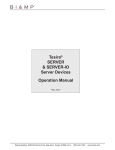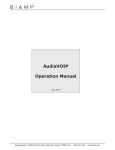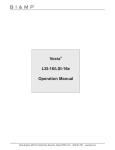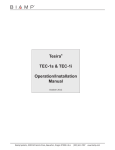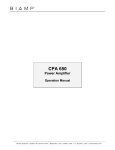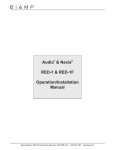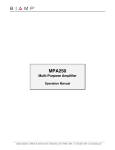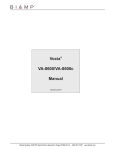Download Biamp Vocia VO-4e Specifications
Transcript
Vocia® VO-4e Operation Manual January 2013 Biamp Systems, 9300 SW Gemini Drive, Beaverton, Oregon 97008 U.S.A. (503) 641-7287 www.biamp.com IMPORTANT SAFETY INSTRUCTIONS IMPORTANT SAFETY INSTRUCTIONS 1) Read these instructions. 2) Keep these instructions. 3) Heed all warnings. 4) Follow all instructions. 5) Do not use this product near water. 6) Clean only with dry cloth. 7) Do not block ventilation openings. Install in accordance with the manufacturer’s instructions. 8) Do not install near any heat sources such as radiators, heat registers, stoves, or other product (including amplifiers) that produce heat. 9) Do not defeat the safety purpose of any grounding-type plug. A grounding type plug has two blades and a third grounding prong. The third prong is provided for your safety. If the provided plug does not fit into your outlet, consult an electrician for replacement of the obsolete outlet. 10) Protect the power cord from being walked on or pinched particularly at plugs, convenience receptacles, and the point where they exit from the product. 11) Only use attachments/accessories specified by the manufacturer. 12) Use only with equipment rack, cart, stand or table designed to provide adequate mechanical strength, heat dissipation and securement to the building structure. When a cart is used, use caution when moving the cart and product combination to avoid injury from tip-over. 13) Unplug this product during lightning storms or when unused for long periods of time. 14) Refer all servicing to qualified service personnel. Servicing is required when the product has been damaged in any way, such as power-supply cord or plug is damaged, liquid has been spilled or objects have fallen into the product, the product has been exposed to rain or moisture, does not operate normally, or has been dropped. WARNING - To reduce the risk of fire or electric shock, do not expose this product to rain or moisture. CAUTION - The Installation steps for ‘Auxiliary Power’ are for use by qualified personnel only and must comply with all local codes. • National Electrical Code, ANSI/NFPA 70 for United States. • Canadian Electrical Code, Part 1, CSA C22.1, Sections 2-128, 12-010(3) and 12-100 for Canada. Explanation of safety related symbols - Product labeling and the operation manual may use the internationally recognized symbols defined below to note safety messages. Lightning Bolt: Hazardous Live voltages present when this unit is in operation. Do not touch terminals marked with this symbol while the unit is connected to live power. Exclamation Point: Replace components (i.e. fuses) only with the values specified by the manufacturer. Failure to do so will compromise safe operation of this unit. 2 TABLE OF CONTENTS VOCIA OUTPUT 4 UNIT WITH EXTENDED CAPABILITY (VO-4e) . . . . . . . . . . . . . . . . . 4 FEATURES. . . . . . . . . . . . . . . . . . . . . . . . . . . . . . . . . . . . . . . . . . . . . . . . . . . . . . . . . . . . . . . . . . . . . . . . . . . . . . . . . . . . . . . . . 4 FRONT PANEL. . . . . . . . . . . . . . . . . . . . . . . . . . . . . . . . . . . . . . . . . . . . . . . . . . . . . . . . . . 5 System Indicators. . . . . . . . . . . . . . . . . . . . . . . . . . . . . . . . . . . . . . . . . . . . . . . . . . . . . . . . . . . . . . . . . . . . . . . . . . . . . . . . . . . 5 Chassis Indicators. . . . . . . . . . . . . . . . . . . . . . . . . . . . . . . . . . . . . . . . . . . . . . . . . . . . . . . . . . . . . . . . . . . . . . . . . . . . . . . . . . . 5 Channel Indicators . . . . . . . . . . . . . . . . . . . . . . . . . . . . . . . . . . . . . . . . . . . . . . . . . . . . . . . . . . . . . . . . . . . . . . . . . . . . . . . . . . 5 REAR PANEL. . . . . . . . . . . . . . . . . . . . . . . . . . . . . . . . . . . . . . . . . . . . . . . . . . . . . . . . . . . 6 Conventions. . . . . . . . . . . . . . . . . . . . . . . . . . . . . . . . . . . . . . . . . . . . . . . . . . . . . . . . . . . . . . . . . . . . . . . . . . . . . . . . . . . . . . . . 6 Auxiliary Power. . . . . . . . . . . . . . . . . . . . . . . . . . . . . . . . . . . . . . . . . . . . . . . . . . . . . . . . . . . . . . . . . . . . . . . . . . . . . . . . . . . . . 6 Network Connections. . . . . . . . . . . . . . . . . . . . . . . . . . . . . . . . . . . . . . . . . . . . . . . . . . . . . . . . . . . . . . . . . . . . . . . . . . . . . . . . 6 CobraNet® LED indication. . . . . . . . . . . . . . . . . . . . . . . . . . . . . . . . . . . . . . . . . . . . . . . . . . . . . . . . . . . . . . . . . . . . . . . . . . . . . 7 Device ID switches . . . . . . . . . . . . . . . . . . . . . . . . . . . . . . . . . . . . . . . . . . . . . . . . . . . . . . . . . . . . . . . . . . . . . . . . . . . . . . . . . . 7 Analog Audio Outputs. . . . . . . . . . . . . . . . . . . . . . . . . . . . . . . . . . . . . . . . . . . . . . . . . . . . . . . . . . . . . . . . . . . . . . . . . . . . . . . 7 Page Active Relay . . . . . . . . . . . . . . . . . . . . . . . . . . . . . . . . . . . . . . . . . . . . . . . . . . . . . . . . . . . . . . . . . . . . . . . . . . . . . . . . . . . 7 Control Inputs. . . . . . . . . . . . . . . . . . . . . . . . . . . . . . . . . . . . . . . . . . . . . . . . . . . . . . . . . . . . . . . . . . . . . . . . . . . . . . . . . . . . . . 7 Control Outputs. . . . . . . . . . . . . . . . . . . . . . . . . . . . . . . . . . . . . . . . . . . . . . . . . . . . . . . . . . . . . . . . . . . . . . . . . . . . . . . . . . . . . 7 Amp Fault Inputs. . . . . . . . . . . . . . . . . . . . . . . . . . . . . . . . . . . . . . . . . . . . . . . . . . . . . . . . . . . . . . . . . . . . . . . . . . . . . . . . . . . . 8 Output Fault Detection (VO-4e output channel used in conjunction with ELD-1). . . . . . . . . . . . . . . . . . . . . . . . . . . . . . . . 8 Failover Modes . . . . . . . . . . . . . . . . . . . . . . . . . . . . . . . . . . . . . . . . . . . . . . . . . . . . . . . . . . . . . . . . . . . . . . . . . . . . . . . . . . . . . 9 Device-to-Device Failover. . . . . . . . . . . . . . . . . . . . . . . . . . . . . . . . . . . . . . . . . . . . . . . . . . . . . . . . . . . . . . . . . . . . . . . . . . . . . 9 Channel-to-Channel Failover. . . . . . . . . . . . . . . . . . . . . . . . . . . . . . . . . . . . . . . . . . . . . . . . . . . . . . . . . . . . . . . . . . . . . . . . . . 9 SPECIFICATIONS. . . . . . . . . . . . . . . . . . . . . . . . . . . . . . . . . . . . . . . . . . . . . . . . . . . . . . . 10 BLOCK DIAGRAM. . . . . . . . . . . . . . . . . . . . . . . . . . . . . . . . . . . . . . . . . . . . . . . . . . . . . . 10 WARRANTY . . . . . . . . . . . . . . . . . . . . . . . . . . . . . . . . . . . . . . . . . . . . . . . . . . . . . . . . . . . 11 FCC COMPLIANCE . . . . . . . . . . . . . . . . . . . . . . . . . . . . . . . . . . . . . . . . . . . . . . . . . . . . . 12 EC DECLARATION. . . . . . . . . . . . . . . . . . . . . . . . . . . . . . . . . . . . . . . . . . . . . . . . . . . . . . 13 EU ROHS COMPLIANT. . . . . . . . . . . . . . . . . . . . . . . . . . . . . . . . . . . . . . . . . . . . . . . . . . 14 3 VOCIA OUTPUT 4 WITH EXTENDED CAPABILITY (VO-4e) The VO-4e is an enhanced networked audio output expansion device that allows the user to add four line-level and CobraNet® output channels to be added to a Vocia system. The VO-4e can be configured for Channel-to-Channel or Device-to-Device failover and uses comprehensive fixed-chain digital-signal processing within the device, including volume control, ducking, equalization, compressor/limiter, speaker crossover, delay, and output gain. Emergency Messages for life-safety systems are stored in non-volatile memory. Two RJ45 connectors on the rear of the device provide redundant connectivity to process control data, audio and power over an Ethernet cable. In addition to this the VO-4e also has dual inputs for accepting power from an Auxiliary supply. The per-channel Paging relay provides a contact closure when Paging is active on an associated channel. FEATURES • CobraNet audio output • Channel-to-Channel and Device-to-Device failover • Local non-volatile storage of Emergency Messages • Dual PoE capable with alternate powering from auxiliary 24V DC supply (dual inputs) • LED status and fault indication -- Chassis Fault, Activity and Status -- PoE Power -- Aux Power -- Output Channel Amp Fault, Activity and Signal Present • Four Page Active Relays, Control Inputs and Control Outputs • Speaker line monitoring and ambient noise compensation supported using ELD-1 and ANC-1 devices • Software-configurable signal processing including volume control, filters, compressor/limiting, delay, speaker equalization, and output level • CobraNet audio/control with dynamic use of available bundles over single Ethernet cable • Dual CobraNet ports for redundancy • Rotary switches for device identification • IP30 Compliant • CE marked, UL listed and RoHS compliant • 19 inch, 1RU housing • Covered by Biamp Systems’ 5-year warranty 4 VO-4e FRONT PANEL Setup and Use The Vocia software provides the interface for configuring and programming the VO-4e. The information supplied by this manual relates to hardware installation, physical connections, device and channel failover concerns. For more details on software setup, please consult the Vocia Software Help File. Chassis Indicators Channel Indicators System Indicators The LED indicators on the front panel provide information and operational status of the unit and associated output channels. LEDs have been grouped into Chassis and Channel indicators. Chassis Indicators These indicators relate to the entire unit (chassis). PoE is a green LED indicator that will illuminate when PoE power is applied to the unit via either or both CobraNet ports. Aux is a green LED indicator that will illuminate when an auxiliary DC supply is applied to the unit via either or both 24V Auxiliary power inputs. Refer to the caution in the Rear Panel Auxiliary Power section. Chassis Fault is a yellow LED indicator that illuminates when a Chassis Fault has occurred. There are two types of Chassis Faults that can be reported depending on the severity of the problem. Flashing yellow indicates a Warning that means some aspect of the unit is not performing within normal specification. Audio may still be passing but if the condition causing the warning is not corrected chassis failure may occur. Solid yellow indicates a fault which means that some aspect of the unit has failed and audio may no longer be passing through the device. Use Vocia software to determine the specific type of chassis warning or Fault that has occurred. Activity is a two-color LED that indicates the configuration status of the device. A solid green LED indicates that the unit is configured. A flashing yellow LED indicates the unit is active but unconfigured. A solid yellow LED indicates the unit is configured and in standby. Standby only occurs when a unit has been designated as a redundant device when Device Failover is enabled. Status is a tri-color LED that indicates the health of the hardware. A green LED indicates that the unit powered up normally. A flashing yellow LED is shown briefly during the power-up self-test and will turn solid green upon successful start. A red LED indicates that the unit experienced a problem during the power-up self-test. Channel Indicators These indicators relate to each of the four channels. Amp Fault is a yellow LED that illuminates when the corresponding Amp Fault Input on the rear of the unit has been asserted. Activity is a two-color LED that illuminates green when that channel is configured and actively passing audio and yellow when that channel is configured and in standby. Standby only occurs when a channel has been designated as redundant channel in a failover configuration. Signal is a tri-color LED that that indicates audio signal presence on the amplifier channel. Green indicates that the audio signal level is between -48 dBFS and -18 dBFS, yellow indicates a signal level between -18 dBFS and -2 dBFS, and red indicates clipping (above -2dBFS). 5 VO-4e REAR PANEL Connections All numbered audio, relay and power connectors on the rear panel of the unit are configured with the lowest output or input on the left of the connector as viewed from the rear of the unit. Auxiliary Power Caution - Due to potential energy hazard, connections to the Auxiliary Power 24V DC inputs must be made by a qualified electrician or other qualified person as required to conform with all local codes. Dual 24V DC power inputs are provided on a four-way 0.2” (5.08mm) pluggable screw terminal block. Monitoring of the supply input is software configurable. If 24V DC is not supplied to a monitored input, a loss-of-supply fault will be reported. If no Auxiliary Power monitoring is required the option must be deselected in the Vocia software to prevent an Auxiliary Supply Fault being reported. A Loss of Supply Fault is indicated via the Vocia software and by a blinking yellow ‘Chassis Fault’ indicator on the front panel. Auxiliary power supplies must meet the voltage range and power requirements detailed in the following specification table. Local standards, norms or codes may require the use of certified power supplies and may require observance of minimum ‘on battery’ running times both for standby and maximum power conditions. If used, dual 24V redundant power supplies must each independently meet the total power requirements of the unit. The pluggable screw terminal connectors provided will accommodate wire sizes from 12-18 AWG. External over-current protection must be provided, according to the current carrying capacity of the connecting wires. The Auxiliary power inputs must not be connected to Chassis or ground. The Auxiliary power must be floating with respect to ground. Network Connections The VO-4e is a CobraNet device. A Primary and Secondary CobraNet connection is provided for this. These connections support powering via 802.3af or 802.3at (type 1) PoE switches or external PoE Supplies. Monitoring of the PoE supply input is software configurable. If PoE power is not supplied to a monitored input, a loss-of-supply fault will be reported. If no PoE Power monitoring is required the option must be deselected in the Vocia software to prevent a PoE Supply Fault error being reported. A Loss of Supply Fault is indicated via the Vocia software and by a flashing yellow ‘Chassis Fault’ indicator on the front panel. All CobraNet routing and bundle assignments are processed by the Vocia devices locally. Vocia makes dynamic use of available bundles in CobraNet. A 100Base-T Ethernet switch (not repeater hub) is required when networking multiple units. CobraNet utilizes standard CAT5, CAT5e, CAT6, or CAT7 cabling, which has a specified maximum length of 328 feet (100 meters). Additional Ethernet switches, or switches which provide fiber-optic interface, can be used to extend the physical distance between units within a network. Please note that CobraNet limits network extensions to seven hops (one-way transmissions) within a network. The CobraNet network connection is configured with the Primary connector on the left and the Secondary (redundant) connector on the right. The Primary and Secondary CobraNet ports are provided to facilitate connection redundancy. Each connector provides two LEDs that indicate Ethernet link and network activity. 6 VO-4e REAR PANEL CobraNet LED indication Left LED Right LED Description None None No Data Connectivity or CobraNet activity None Flashing green Network Link established. Typically seen on Secondary port when acting as a failover to the Primary connection. Yellow Flashing green Network Link established. Typically seen on Secondary port when acting as a failover to the Primary connection. Flashing yellow Flashing green Network Link established and CobraNet activity detected; The unit is acting as a CobraNet Conductor Flashing yellow None CobraNet fault. Check cabling and configuration for errors Device ID switches The rotary ID switches are located on the back of the unit and are used to provide a unique Device ID. The switches are in hexadecimal format. All Vocia units of the same type must have a unique Device ID to function properly within a Vocia Paging World (for instance, it is not possible to have two Vocia Devices of the same type with the same Device ID of hex 07). As an example, to assign a Device ID of hex 07, leave the MSB switch on 0, turn the LSB switch to 7. To create an ID of hex B7, turn the MSB switch on B, and turn the LSB switch to 7. Device ID switches should be set using a 0.1 inch (2.5mm) to 0.12 inch (3.0mm) flat blade screwdriver. More information on setting IDs and the hexadecimal numbering scheme used can be found in the Vocia Software Help File. Analog Audio Outputs Four 0.2” (5.08mm) three way pluggable barrier strip connectors are provided for analogue audio signal output. The Vocia software enables a nominal output level of -10dBu, 0dBu or +4dBu to support a wide range of connection devices. Page Active Relays Page Active Relays (PAR) are provided in the form of one Form C (single pole, changeover) relay presented per output channel. Each PAR connector is a six way 3.5mm pluggable barrier strip connector. The Page Active relay connections are labeled as follows: • C – Relay Common • NC – Normally Closed • NO – Normally Open Control Inputs Four separate Control Inputs are provided via a six-way 0.2” (5.08mm) pluggable screw terminal block. Each Control Input allows for an external voltage-free contact closure to ground to assert a Control Input Event as configured in Vocia software. In addition to the four control inputs, a ground and 10V reference Out (100mA) is provided. When configured for device failover the Control Input connections must be paralleled between the main and failover device. Control Outputs Four Control Outputs are provided via two six-way 0.2” (5.08mm) pluggable screw terminal blocks. Each Output has a Common, Normally Closed (NC) and a Normally Open (NO) connection. Outputs will be capable of being associated with control Output Events configured in Vocia software. Both NC and NO connections are able to be used at the same time. When configured in a Failover Mode the Controls outputs are able to be used to indicate the active state of the respective output channel. When configured for device failover as NO and NC relay connections are being used, consideration should be given to the performance of the circuit before and after failover. 7 VO-4e REAR PANEL Amp Fault Imputs Four amplifier Fault Inputs are provided via a six-way 0.2” (5.08mm) pluggable screw terminal block. These allow for fault monitoring of the output of the VO-4e as indicated from an external amplifier. By default each input allows an external voltage-free contact closure to ground to indicate a fault condition for the corresponding VO-4e Output channel. Inputs are pulled high internally to create a default non-asserted condition. When configured for device failover the Amp Fault Input connections must be paralleled between the main and failover device. This is software configurable so if inverse operation is required this can be adjusted per input. Output Fault Detection (VO-4e output channel used in conjunction with a Vocia End of Line Device 1 [ELD-1]) The VO-4e monitors audio output circuit integrity per channel by monitoring multiple out-of-band (inaudible), high frequency tones in conjunction with ELD-1 devices that have been assigned to the relevant channel using the Vocia software. To prevent the possibility of interference with these monitored tones: • Recorded audio messages or audio content with continuous or swept tonal components (e.g., alert tones) should be band limited at 15 kHz during recording; • Program signal levels should be adjusted to minimize clipping, as severely clipped signals may also affect these out-of-band fault detection tones. • The use of shielded speaker cable is not supported; • Highly capacitive speaker lines or loads may prevent correct operation of the ELD detection system; • Legacy monitored speaker circuits that use capacitors and resistors or similar methods must have all legacy monitoring circuitry removed for correct operation of the ELD detection system; • If legacy speaker systems and speaker wiring are to be re-used, these must conform with the requirements herein; • Any external power amplifier equipment must be capable of relaying the out-of-band fault detection tones to the ELD-1. For reliableperformance a frequency response of better than -3dB at 24kHz must be supported through the amplifier and all speaker wiring up to the End of Speaker Line connections on the ELD-1s; • The amplifier gain or level control must be set so that nominal output level from the VO-4e (-10dBu, 0dBu or +4dBu; as set in Vocia software) delivers an output level from the amplifier 6dB below the amplifier maximum output level (clip level). This setting must be accurate and must remain constant for predictable operation of ELD-1 units. 8 VO-4e REAR PANEL Failover Modes Device-to-Device or Channel-to-Channel failover modes are supported. Only one type of failover mode can be implemented per device. Device-to-Device Failover VO-4e units provide for Device-to-Device failover when a fault is detected. A Failover Link Cable must be connected between the primary and the redundant units as shown below. Connect ground to ground, and Pin 1 of the primary device to Pin 2 of the redundant device; connect Pin 2 of the primary device to Pin 1 of the redundant device. Failover is triggered by any of the following conditions: • Chassis Fault • Channel Fault • Loss of power • Loss of CobraNet link • Loss of Failover Link Cable • ELD-1 / speaker line Fault (if enabled in software) • External amplifier Faults being asserted Only Chassis and Channel Faults trigger the Device failover mechanism. Abnormal conditions that do not immediately impair audio will appear as warnings but will not trigger failover. After a failover condition has been asserted, a power cycle of the units is required to recover from the failover. This can be done either by physically repowering the devices or by performing a ‘Device Reset’ in the Vocia software via the Test tab of the device dialog. The units are required to be reset within 10 seconds of each other in order to ensure the primary device resumes control. Channel-to-Channel Failover Channel-to-Channel failover is supported as 1:1 Channel. In this configuration, channel pairs can be specified and adjacent channels will act as a redundant backup. Channel 2 will act as backup for Channel 1 and Channel 4 will act as backup for Channel 3. Channel failover is triggered by either a Channel Failure Fault, an ELD-1/Speaker Line Fault (if enabled in software) or an amplifier Fault Input being asserted. The VO-4e will return to normal operation after the Fault condition is cleared and the unit is re-powered or reset via the Test tab in the Properties sheet. 9 VO-4e SPECIFICATIONS Vocia Output 4e SPECIFICATIONS Message Memory: Network Audio: Network Connections: Nominal Output Level: Maximum Output Level: Maximum Output Load: Dynamic Range: Frequency Response: THD + Noise (20Hz-10kHz): Power: PoE: Aux Voltage Nominal: Fault & Control Input Ports: Assert: Un-assert: Input Impedance: Max. short circuit current: 5.625 MB Page Active Relays & Control Out Relays: Type: Dual RJ45 with shielded Ethernet cable (CAT5, CAT5e, CAT6, or CAT 7) Max Operating Voltage: Max Switching Capacity: -10dBu, 0dBu, +4dBu (selectable) Min Operating Load: +22dBu Dimensions: 2kΩ Height: Width: >100dB Depth: 20Hz-20kHz +/- 1dB Weight: <0.05% Compliance: 20-bits, 48kHz, 5-1/3 ms (fixed) IEEE 802.3af Class 3 IEEE 802.3at Type 1 Class 3 24V DC; <100mV Ripple (Max 15W) Environment: Ambient Operating Temperature Range: Voltage free contact to ground Humidity: Open Circuit Altitude: 100kΩ 1mA Vocia Output 4e BLOCK DIAGRAM 10 Single Form C voltage free change over contact 125V AC, 60V DC 37 VA 10µA 10mV DC 1.75 inches (44.5mm) 19 inches (483mm) 10 inches (254mm) 6.6 lbs. (3kg) FCC Part 15, Class B CE Marked EU Directive 2002/95/EC, RoHS Directive UL 60065 Listed, E215636 C-UL Listed, E215636 C-Tick, N24138 (Australia) 23 – 104° F (-8 – 42° C) 0 – 95%RH non-condensing 0 – 10,000 Feet (0 - 3000 Meters) MSL VO-4e WARRANTY BIAMP SYSTEMS IS PLEASED TO EXTEND THE FOLLOWING 5-YEAR LIMITED WARRANTY TO THE ORIGINAL PURCHASER OF THE PROFESSIONAL SOUND EQUIPMENT DESCRIBED IN THIS MANUAL 1. BIAMP Systems warrants to the original purchaser of new products that the product will be free from defects in material and workmanship for a period of 5 YEARS from the date of purchase from an authorized BIAMP Systems dealer, subject to the terms and conditions set forth below. 2 If you notify BIAMP during the warranty period that a BIAMP Systems product fails to comply with the warranty, BIAMP Systems will repair or replace, at BIAMP Systems’ option, the nonconforming product. As a condition to receiving the benefits of this warranty, you must provide BIAMP Systems with documentation that establishes that you were the original purchaser of the products. Such evidence may consist of your sales receipt from an authorized BIAMP Systems dealer. Transportation and insurance charges to and from the BIAMP Systems factory for warranty service shall be your responsibility. 3. This warranty will be VOID if the serial number has been removed or defaced; or if the product has been altered, subjected to damage, abuse or rental usage, repaired by any person not authorized by BIAMP Systems to make repairs; or installed in any manner that does not comply with BIAMP Systems’ recommendations. 4. Electro-mechanical fans, electrolytic capacitors, gooseneck microphones, cords connecting handheld microphones, hard-drives, displays, and normal wear and tear of items such as paint, knobs, handles, keypads and covers are not covered under this warranty. All server-based devices are warranted for 3 years only. 5. This warranty is in lieu of all other warranties, expressed or implied. Biamp Systems disclaims all other warranties, expressed or implied, including, but not limited to, implied warranties of merchantability and fitness for a particular purpose. 6. The remedies set forth herein shall be the purchaser’s sole and exclusive remedies with respect to any defective product. 7. No agent, employee, distributor or dealer of Biamp Systems is authorized to modify this warranty or to make additional warranties on behalf of Biamp Systems. Statements, representations or warranties made by any dealer do not constitute warranties by Biamp Systems. Biamp Systems shall not be responsible or liable for any statement, representation or warranty made by any dealer or other person. 8. No action for breach of this warranty may be commenced more than one year after the expiration of this warranty. 9. Biamp systems shall not be liable for special, indirect, incidental, or consequential damages, including lost profits or loss of use arising out of the purchase, sale, or use of the products, even if BIAMP Systems was advised of the possibility of such damages. 013113_585.0359.90B 11 FCC COMPLIANCE FCC NOTICE - CLASS B DIGITAL DEVICE NOTE: This equipment has been tested and found to comply with the limits for a Class B digital device, pursuant to Part 15 of the FCC Rules. These limits are designed to provide reasonable protection against harmful interference in a residential as well as in a commercial environment. This equipment generates, uses, and can radiate radio frequency energy and, if not installed and used in accordance with the instructions, may cause harmful interference to radio communications. However, there is no guarantee that interference will not occur in a particular installation. If this equipment does cause harmful interference to radio or television reception, which can be determined by turning the equipment off and on, the user is encouraged to try to correct the interference by one or more of the following measures: 1) Reorient or relocate the receiving antenna, 2) Increase the separation between the equipment and receiver, 3) Connect the equipment into an outlet on a circuit different from that to which the receiver is connected, or 4) Consult the dealer or an experienced radio/TV technician for help. 12 COMPLIANCE DoC VO4E201203 EC Declaration of Conformity Biamp Systems Corporation, as manufacturer having sole responsibility, hereby declares that the following described product complies with the applicable provisions of the DIRECTIVES below except as noted herein. Any alterations to the product not agreed upon and directed by Biamp Systems Corporation will invalidate this declaration. Brand Name: Vocia® Product Model: VO-4e Product Description: Output Expander, Enhanced Applicable EC Directives: Applicable Harmonized Standards: LVD Directive (2006/95/EC) Safety EN 60065:2002, Am 1:2006, Am 11:2008 EMC Directive (2004/108/EC) Emissions Immunity EN 55103-1:2009, Environment E2, Class B EN 55103-2:1996, Environment E2 RoHS Directive (2011/65/EU) RoHS Recast Special Considerations for Product Environment or Compliance: • • • Use only CE marked PoE insertion device. Use only CE and “LPS” marked 24 VDC External Power Adaptor or DC Source complying with all local regulations. Shielded cabling must be used for system connections. Technical Construction File, Location and Contact: Biamp Systems Corporation 9300 S.W. Gemini Drive Beaverton, OR USA 97008 phone: fax: e-mail: (503) 641.7287 (503) 626.0281 [email protected] Signed for and on behalf of Biamp Systems Corporation: Authorized Representative: Larry Copley, Compliance Engineer Authorized Signature: Place / Date Issued: Beaverton, OR / March 2012 13 COMPLIANCE EU RoHS COMPLIANT This Biamp product, including all attendant cables and accessories supplied by Biamp, meets all requirements of EU Directives 2011/65/EU of 8 June 2011, the EU RoHS Recast. An EU RoHS Materials Content Declaration document may be obtained at www.biamp.com The following information is presented to comply with Chinese law SJ/T11363-2006. 有 害 物 质 表 (Hazardous Substances Table) Biamp Systems Corporation 音频输出设备 (Audio Output Device) Vocia VO-4e 设备机箱 (Equipment Chassis) Pb 铅 X 插拔式接线端子 (Plug-in Terminal Blocks) 光盘 (CD ROM) 手册和其他书面文档 (Manual and Documentation) 包装箱和所有包装材料 (Box and Packing Materials) O O O O 部件名称 (Part Name) 有毒有害物质或元素 (Substances) Hg Cd Cr+6 PBB PBDE 汞 镉 六价铬 O X O O O O O O O O O O O O O O O O O O O O O O O 0:表示该部件所有均质材料中的这种有毒有害物质低于 SJ/T11363-2006 的限制要求. X:表示该部件中至少有一种均质材料所含的这种有毒有害物质高于 SJ/T11363-2006 的限制要求. 在电触头和(或)镀镉所含的均质材料中,镉及其化合物的含量可以超过 0.01%,但欧盟指令 91/338/EEC(根据欧盟指令 76/769/EEC)限制销售和使用某些危险物质和制剂部分中所禁止的用途除外 在以下一种或多种物质所含的均质材料中,铅及其化合物的含量可以超过 0.1%: 1) 电子元器件中玻璃内所含的铅 2) 铅在钢材中是作为一种合金元素,含量可达 0.35% 3) 铅在铝材中是作为一种合金元素,含量可达 0.4% 4) 铅在铜材中是作为一种合金元素,含量可达 4% 5) 高熔点类焊料中的铅(即铅料合金,铅含量超过 85%) 6) 电子陶瓷部件内的铅 7) 由两种以上元素组成的焊料中所含的铅,用于连接针脚和微处理器包装,其中 铅的含量超过 80% 但低于 85% 8) 顺应针连接系统内的铅 9) 倒装芯片封装中半导体芯片及载体之间形成可靠连接所用焊料中的 在正常使用情况下,中国环保使用期限为 10 年,条件是: • 环境温度为 0-40C (32-104°F) • 湿度为 0-95%,无凝结 • 海拔高度为 0-10,000 英尺 • 气流不受阻碍 • 没有水或其他液体进入任何部件 • 电源为 IEEE 802.3af PoE • 部件没有损坏(损坏部件应立即修理) • �������������������� 14















